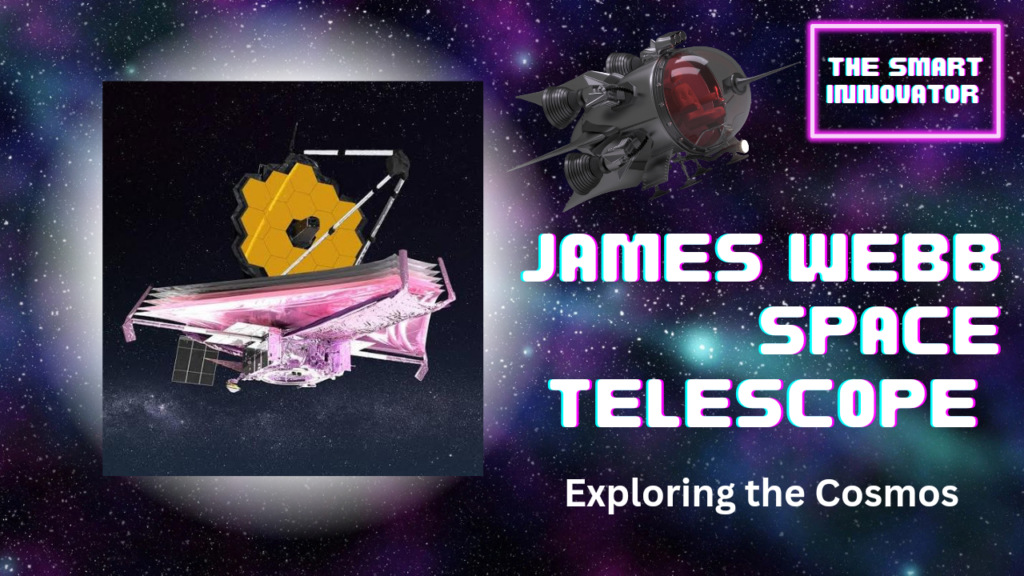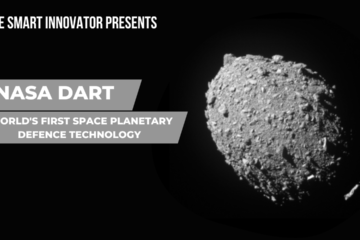James Webb Space Telescope – Exploring the Cosmos
The James Webb Space Telescope (JWST) is an extraordinary marvel of modern astronomy. With its advanced technology and remarkable capabilities, it promises to revolutionize our understanding of the universe. In this article, we will delve into the fascinating world of the JWST, its scientific objectives, and the groundbreaking discoveries it aims to make. The James Webb Space Telescope (JWST) is designed to have significantly greater sensitivity and capabilities compared to its predecessors. While it’s challenging to provide an exact distance the JWST can “see” due to the complexity of astronomical observations, the telescope’s advanced instruments enable it to observe extremely distant objects in the universe.

A Glimpse into the Future of Space Observation
The JWST is equipped with a suite of cutting-edge instruments designed to address key scientific questions about the cosmos. From studying the formation of galaxies to investigating the origins of life, the telescope’s scientific objectives are as diverse as they are ambitious.
The James Webb Space Telescope (JWST) is a collaborative project led by NASA (National Aeronautics and Space Administration) in partnership with international space agencies, including the European Space Agency (ESA) and the Canadian Space Agency (CSA).
As the primary organization responsible for the development and operation of the JWST, NASA plays a central role in managing the project. NASA’s Goddard Space Flight Center in Greenbelt, Maryland, oversees the overall mission and serves as the home of the project management team.
The European Space Agency (ESA) is a major partner in the JWST mission. ESA contributes key elements to the telescope, including the NIRSpec (Near-Infrared Spectrograph) instrument and the Optical Bench Assembly (OBA) for the Mid-Infrared Instrument (MIRI).
The Canadian Space Agency (CSA) also participates in the JWST project by providing the Fine Guidance Sensor/Near InfraRed Imager and Slitless Spectrograph (FGS/NIRISS), which is one of the four scientific instruments onboard the telescope.
Therefore, the JWST is a collaborative effort between NASA, ESA, and CSA, reflecting the international cooperation in advancing space exploration and scientific discovery.
Probing the Early Universe: Peering Back in Time
One of the primary goals of the JWST is to explore the early universe and shed light on its formation and evolution. By observing distant galaxies and their star formation processes, scientists hope to unravel the mysteries of cosmic origins and better understand how galaxies, stars, and planets came into existence.
The JWST’s primary goal is to study the earliest galaxies that formed after the Big Bang, which are located billions of light-years away. It aims to peer deep into space and observe objects that existed when the universe was only a fraction of its current age.
Hunting Exoplanets: The Quest for Habitable Worlds
The JWST’s capabilities extend beyond our galaxy, as it aims to study exoplanets orbiting distant stars. By analyzing the composition of exoplanet atmospheres, scientists can search for signs of habitability and potentially detect the presence of key molecules that could indicate the existence of life beyond Earth.
The telescope’s large primary mirror, combined with its suite of scientific instruments optimized for infrared observations, allows it to detect the faintest signals from distant celestial objects. It can capture detailed images, study the chemical composition of stars and galaxies, and analyze the atmospheres of exoplanets.
The JWST’s enhanced sensitivity and infrared capabilities enable it to push the boundaries of observational astronomy, reaching farther into space and exploring regions that were previously inaccessible to other telescopes. It promises to uncover new insights into the early universe, galaxy formation, and the existence of potentially habitable exoplanets.
The Technological Marvels of the JWST
The James Webb Space Telescope pushes the boundaries of engineering and technology to overcome the challenges of space exploration. From its segmented primary mirror to its advanced sunshield, the JWST incorporates innovative solutions to ensure its success in the harsh conditions of space.
The scientific community and the public alike are eagerly awaiting the launch of the JWST. Its potential for groundbreaking discoveries, such as uncovering the secrets of dark matter or observing the formation of planetary systems, has generated immense excitement and anticipation.
How does james webb telescope work?
The James Webb Space Telescope (JWST) works by using advanced technologies and instruments to observe the universe from its vantage point in space. Here’s a simplified explanation of how it functions:
1. Launch and Deployment: The JWST is launched into space aboard a rocket and deployed in a specific orbit around the Earth. Once deployed, it begins its scientific mission.
2. Primary Mirror: The JWST’s primary mirror is a key component. It consists of 18 hexagonal mirror segments that work together to collect and focus incoming light. These segments are coated with a thin layer of gold to enhance their reflectivity in the infrared range.
3. Infrared Observation: The JWST is designed to observe the universe primarily in the infrared part of the electromagnetic spectrum. This is because infrared light can penetrate dust clouds and reveal objects that are otherwise obscured in visible light.
4. Instruments: The JWST is equipped with four main scientific instruments: the Near Infrared Camera (NIRCam), the Near Infrared Spectrograph (NIRSpec), the Mid-Infrared Instrument (MIRI), and the Fine Guidance Sensor/Near InfraRed Imager and Slitless Spectrograph (FGS/NIRISS). These instruments capture images, obtain spectra, and gather scientific data from the observed celestial objects.
5. Sunshield: To protect the sensitive instruments from the Sun’s heat and light, the JWST is equipped with a five-layered sunshield. This sunshield helps maintain a stable and cool environment for the telescope, allowing it to operate at cryogenic temperatures.
6. Pointing and Positioning: The JWST uses a combination of thrusters, gyroscopes, and reaction wheels to maintain its precise pointing and positioning in space. This ensures that the telescope is accurately directed towards the desired astronomical targets.
7. Data Transmission: The JWST captures vast amounts of data during its observations. This data is compressed and then transmitted back to Earth using high-speed communication systems. Once received, scientists and engineers analyze the data to gain insights into various astrophysical phenomena.
8. Scientific Mission: The JWST’s primary mission is to study the early universe, the formation of stars and galaxies, and the evolution of planetary systems. It aims to help answer fundamental questions about our cosmic origins and provide valuable data for astronomers and scientists worldwide.
It’s important to note that the above explanation is a simplified overview of the JWST’s functioning. The actual workings of the telescope involve complex engineering, precise calibration, and sophisticated scientific analysis.
The James Webb Space Telescope (JWST) is an infrared telescope, which means it can see light that is invisible to the human eye. Infrared light is emitted by objects that are very hot or very cold, so JWST can see objects that are too faint or too distant to be seen by other telescopes.
JWST’s primary mirror is made up of 18 hexagonal segments that are each about the size of a coffee table. The mirror is so large because it needs to collect as much infrared light as possible. The mirror reflects the light onto a smaller secondary mirror, which then directs the light into the telescope’s four scientific instruments.
The four scientific instruments are:
- NIRCam (Near-Infrared Camera): This instrument is used to image and study objects in the near-infrared spectrum.
- NIRSpec (Near-Infrared Spectrograph): This instrument is used to analyze the composition of objects by splitting their light into a spectrum.
- MIRI (Mid-Infrared Instrument): This instrument is used to image and study objects in the mid-infrared spectrum.
- NIRISS (Near-Infrared Imager and Slitless Spectrograph): This instrument is used to image and study objects in the near-infrared spectrum, and it can also be used to take slitless spectroscopy.
JWST is a powerful telescope that will allow astronomers to study the universe in unprecedented detail. It is expected to make many new discoveries about the formation of galaxies, the evolution of stars and planets, and the search for life beyond Earth.
How will the JWST contribute to our understanding of the early universe?
The James Webb Space Telescope (JWST) is expected to make significant contributions to our understanding of the early universe. Here are some ways in which the JWST will advance our knowledge:
- First Light and Reionization: The JWST will study the period when the first galaxies formed and the universe transitioned from a neutral state to an ionized one. By observing distant galaxies, the telescope will help astronomers unravel the mysteries of how stars and galaxies formed and evolved in the early universe.
- Cosmic Dawn: The JWST will peer back in time to the era known as the “cosmic dawn” when the first light-emitting structures, such as stars and galaxies, began to form. It will observe the faint signals from these early cosmic objects, providing valuable insights into their properties and the conditions that prevailed during their formation.
- Revealing Exoplanets: The JWST will investigate exoplanetary systems and their atmospheres, including potentially habitable exoplanets. By studying the composition and characteristics of exoplanet atmospheres, the telescope will contribute to our understanding of the prevalence and nature of worlds beyond our solar system.
- Chemical Evolution: By analyzing the spectral signatures of distant galaxies, the JWST will help scientists trace the chemical evolution of the universe. It will shed light on the abundance of elements and the processes that led to the formation of heavy elements crucial for the existence of life.
- Gravitational Lensing: The JWST will exploit the phenomenon of gravitational lensing, where the gravity of massive objects bends and magnifies light from more distant objects. This will allow astronomers to study the faintest and most distant galaxies, offering a unique perspective on galaxy formation and evolution.
In summary, the JWST’s advanced capabilities, such as its larger mirror and infrared sensitivity, will enable groundbreaking observations of the early universe. It holds great promise for unraveling cosmic mysteries and expanding our understanding of the universe’s origins and evolution.
What are the key differences between the JWST and its predecessor, the Hubble Space Telescope?
| Aspect | James Webb Space Telescope (JWST) | Hubble Space Telescope |
|---|---|---|
| Size | Larger: 6.5-meter primary mirror | Smaller: 2.4-meter primary mirror |
| Observing Range | Infrared spectrum | Visible and ultraviolet range |
| Instruments | NIRCam, NIRSpec, MIRI, FGS/NIRISS | Wide Field Camera 3, COS, ACS |
| Observing Targets | Early universe, exoplanet atmospheres, star and planetary system formation | Stars, galaxies, nebulae, exoplanets |
| Location | About 1.5 million kilometers from Earth, at the second Lagrange point (L2) | Orbiting around Earth at about 550 kilometers |
| Scientific Objectives | Study early universe, exoplanets, star and planetary system formation | Explore various celestial objects, study the expansion of the universe |
What planets will James Webb telescope see?
The James Webb Space Telescope (JWST) has the potential to observe a wide range of celestial objects, including planets within our own solar system and those outside of it. Here are some key aspects related to the planets the JWST could study:
1. **Planets within our solar system:** The JWST can provide detailed observations of the planets in our own solar system, such as Jupiter, Saturn, Mars, and others. It can study their atmospheres, weather patterns, and surface features with enhanced resolution and sensitivity.
2. **Exoplanets:** One of the primary goals of the JWST is to study exoplanets, which are planets orbiting stars beyond our solar system. It will focus on characterizing the atmospheres of these distant worlds, searching for signs of habitability, and potentially detecting biomarkers indicative of life.
3. **Super-Earths and gas giants:** The JWST will be particularly well-suited to study super-Earths and gas giants orbiting other stars. These exoplanets are larger than Earth but smaller than gas giants like Jupiter. By analyzing their atmospheres, the telescope can help scientists understand their compositions, temperature profiles, and potential for hosting life.
4. **Habitable zone planets:** The JWST will target planets located within the habitable zone of their parent stars. This region around a star is where conditions may be suitable for liquid water to exist on the planet’s surface, which is considered a crucial factor for the potential development of life. By studying the atmospheres of these planets, the telescope can provide insights into their habitability.
It’s important to note that the specific planets the JWST will observe will depend on various factors, including the telescope’s observing schedule, scientific objectives, and target selection criteria. The primary focus will be on exploring and characterizing a diverse range of exoplanets to deepen our understanding of planetary systems and the potential for life beyond Earth.
What are the primary scientific instruments onboard the JWST?
The James Webb Space Telescope (JWST) is equipped with four primary scientific instruments, each designed to perform specific observations and measurements. These instruments are:
- Near Infrared Camera (NIRCam): NIRCam is the primary imaging instrument onboard the JWST. It operates in the near-infrared range and is capable of capturing high-resolution images of celestial objects. It will be used for various purposes, including studying distant galaxies, star formation regions, and detecting exoplanets.
- Near Infrared Spectrograph (NIRSpec): NIRSpec is a versatile spectrograph that covers the near-infrared wavelength range. It allows astronomers to analyze the spectra of celestial objects, providing valuable information about their composition, temperature, and other properties. NIRSpec will be particularly useful for studying the formation and evolution of galaxies.
- Mid-Infrared Instrument (MIRI): MIRI operates in the mid-infrared range, which is crucial for studying cool objects, such as protoplanetary disks and distant galaxies. It combines several scientific functions, including imaging, spectroscopy, and coronagraphy. MIRI’s unique capabilities will help astronomers investigate the early universe, the formation of stars, and the characterization of exoplanets.
- Fine Guidance Sensor/Near InfraRed Imager and Slitless Spectrograph (FGS/NIRISS): FGS/NIRISS serves a dual purpose as a fine guidance sensor and a science instrument. Its primary role is to provide extremely precise pointing and stabilization of the telescope. Additionally, NIRISS has capabilities for imaging and slitless spectroscopy in the near-infrared range. It will contribute to various scientific investigations, including exoplanet characterization and the study of distant galaxies.
These four instruments work together to capture images, obtain spectra, and gather valuable scientific data across different wavelengths. They enable astronomers to explore a wide range of astrophysical phenomena and address key scientific questions related to the origins and evolution of the universe
How many light years can James Webb see?
The James Webb Space Telescope (JWST) is not designed to directly observe objects or events in terms of specific distances measured in light-years. Instead, its primary goal is to observe the universe at different wavelengths of light, including infrared, and to study various celestial objects and phenomena.
With its advanced instruments and capabilities, the JWST will be able to peer deeper into space than any previous space telescope. It will have the ability to observe the formation of the first galaxies, the birth of stars, and the evolution of planetary systems, among other scientific objectives.
The JWST’s observations will extend our understanding of the universe’s early history and provide insights into the formation of galaxies and the development of planetary systems. It will capture light from objects that are located billions of light-years away, allowing us to study the universe in its infancy.
While the JWST’s observations will provide valuable data on distant objects, it is important to note that its ability to “see” is not solely determined by distance in terms of light-years. Rather, its capabilities depend on factors such as the brightness of the objects being observed, the sensitivity of its instruments, and the amount of observation time allocated for specific targets.
In summary, the JWST’s observations will take us back in time and allow us to explore the universe’s early stages, but the concept of “seeing” in terms of specific light-year distances is not directly applicable to its observations.
How long is the expected operational lifespan of the JWST?
The expected operational lifespan of the James Webb Space Telescope (JWST) is approximately 10 years. However, this estimate is based on several factors, including the amount of fuel required for the telescope’s propulsion system and the expected degradation of its scientific instruments over time.
The JWST is designed to operate in an environment located about 1.5 million kilometers (nearly 1 million miles) away from Earth, at the second Lagrange point (L2). This location provides a stable and relatively uninterrupted view of the cosmos. Unlike the Hubble Space Telescope, which has been serviced and upgraded by space shuttle missions, the JWST is not designed for on-orbit servicing. Its intricate design and positioning at L2 make servicing missions impractical.
To maximize its operational lifespan, the JWST has been equipped with systems and instruments designed to withstand the harsh conditions of space and to minimize degradation. However, like any complex piece of equipment, there is always the possibility of unforeseen challenges or technical issues arising during its mission.
Despite the anticipated 10-year operational lifespan, it is important to note that the scientific impact of the JWST is expected to be significant and lasting. The telescope’s capabilities and the wealth of data it will collect during its mission will contribute to our understanding of the universe for many years to come, even beyond its operational lifespan.
Conclusion
The James Webb Space Telescope represents a new era in space exploration and scientific discovery. With its advanced capabilities, it is poised to unveil the secrets of the cosmos, expand our knowledge of the universe, and inspire future generations of astronomers and scientists. As we eagerly await its launch, the JWST promises to reshape our understanding of the universe and take us on a breathtaking journey through the cosmos.
So how you find this cover story tell us in the comment section and follow The Smart Innovator for more such exciting content.
Frequently Asked Questions
The James Webb telescope is currently located at the second Lagrange point (L2), which is 1.5 million miles (2.4 million kilometers) away from Earth.
The James Webb telescope can see objects up to 13 billion light-years away.
NASA owns the Webb telescope, but it is an international collaboration between NASA, the European Space Agency (ESA), and the Canadian Space Agency (CSA).
James webb space telescope haalready launched at 25 Dec 2021.








0 Comments